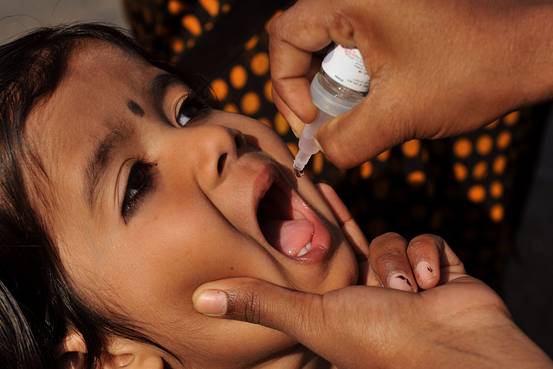
India’s aggressive eradication of polio established the template for moving a disease from endemic to eliminated and has been lauded by the World Health Organization.
But in the process, a rise in the prevalence of another polio-like condition, acute flaccid paralysis, has been recorded.
Known as AFP, the condition is the sudden onset of muscle weakness or the inability to move limbs, and can be a tell-tale sign of polio, but is also a symptom of other diseases, including transverse myelitis, which causes injury to the spinal cord, Guillain Barre Syndrome, a nerve disorder, and Japanese Encephalitis, a mosquito-borne virus.
Since 1997, children in India who present with AFP are immediately tested for polio to comply with polio-eradication protocol and doing so has been one of the foundation stones for eradication.
Just this month, more than 200 young patients in the country’s most-populous state Uttar Pradesh, suffering from AFP were tested for polio. They didn’t have the virus, the federal Health Ministry said in a statement.
Such surveillance has resulted in a huge rise in reported cases of AFP.
In 2003, when polio was endemic in India, 8,500 cases of AFP were recorded. So far in 2015, a year after India was declared polio free, there have been nearly 18,000 reported instances but none linked to polio.
Often the cause of AFP remains unknown.
The rise in cases is thought by most scientists to simply be the result of better screening. But it has prompted some researchers to look at whether the condition could be the result of other polio-like viruses, known as non-polio enteroviruses, or if it could even be brought on by the use of the polio vaccine.
Research by Dr. Jacob Puliyel from St. Stephen’s Hospital in Delhi and two colleagues shows a positive correlation between the number of doses of polio vaccine given to a child on average in a state and the number of reported cases of AFP that turn out not to be caused by polio.
In Uttar Pradesh and Bihar, non-polio AFP cases are higher than in Kerala and Goa, where fewer doses of oral vaccine are administered per child each year, even after factoring in other differences between the states.
“We speculate that repeatedly giving polio virus vaccine is probably causing a strange shift… and there is some other polio-like disease which is beginning to exist,” Dr. Puliyel said in a phone interview.
This needs further studying, he added. Dr. Puliyel’s findings are however disputed as “misguided” and “wrong” by Naveen Thacker, who was part of the team that led India’s polio eradication campaign and is president-elect of the Asia Pacific Pediatric Association.
Research suggests that after a country has eradicated polio, many AFP cases will continue to be associated with non-polio enteroviruses that are common in infants and children, but rarely cause severe illness.
Study of these diseases was neglected in India as public health efforts focused their gaze on polio but has picked up in recent years.
One group of scientists, led by C. Durga Rao, a microbiologist at the Indian Institute of Science in Bangalore, found that in samples taken from nearly 2,800 Indian children with non-polio AFP between 2007 and 2009, about 35% tested positive for non-polio enterovirus infections.
The study, published in 2012, showed that the most-prevalent virus among them was EV 71, which for decades has been related to AFP elsewhere in the world, but Dr. Rao said the findings were the first to detect it in a large number of cases in India.
EV 71 can cause AFP and is also linked to diseases like meningitis, encephalitis (swelling in the brain) and hand, foot and mouth disease.
“Considering the wide range of crippling and deadly diseases associated with enterovirus infections, the lack of active research on these viruses in India is of great concern,” Dr. Rao wrote in an article titled “Non-Polio Enteroviruses, the Neglected and Emerging Human Pathogens: Are We Waiting for the Sizzling Enterovirus Volcano to Erupt?” published in Proceedings of the Indian National Science Academy, an Indian scientific journal, in March.
“With the eradication of wild poliovirus transmission in the country, non-polio enteroviruses are likely to occupy the center stage in the category of major human pathogens associated with emerging and yet to be recognized human and animal diseases in the 21st century,” he added.